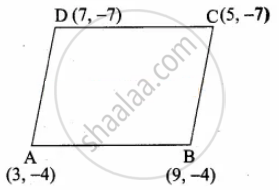Advertisements
Advertisements
Question
Let A(3, – 4), B(9, – 4), C(5, – 7) and D(7, – 7). Show that ABCD is a trapezium.
Solution
Let A(3, – 4), B(9, – 4), C(5, – 7) and D(7, – 7) are the vertices of a quadrilateral.
Slope of a line = `(y_2 - y_1)/(x_2 - x_1)`
Slope of AB = `(-4 + 4)/(9 - 3) = 0/6`= 0
Slope of BC = `(-7 + 4)/(5 -9)= (-3)/(-4) = 3/4`
Slope of CD = `(-7 + 7)/(7 - 5) = 0/2` = 0
Slope of AD = `(-7 + 4)/(7 - 3) = (-3)/4 = - 3/4`
The slope of AB and CD are equal.
∴ AB is parallel to CD. Similarly, the slope of AD and BC are not equal.
∴ AD and BC are not parallel.
∴ The Quadrilateral ABCD is a trapezium.
APPEARS IN
RELATED QUESTIONS
What is the slope of a line whose inclination with positive direction of x-axis is 90°
What is the slope of a line whose inclination with positive direction of x-axis is 0°
Find the slope of a line joining the points
`(5, sqrt(5))` with the origin
Find the slope of a line joining the points
(sin θ, – cos θ) and (– sin θ, cos θ)
Show that the given points are collinear: (– 3, – 4), (7, 2) and (12, 5)
If the three points (3, – 1), (a, 3) and (1, – 3) are collinear, find the value of a
Show that the given points form a parallelogram:
A(2.5, 3.5), B(10, – 4), C(2.5, – 2.5) and D(– 5, 5)
If the points A(2, 2), B(– 2, – 3), C(1, – 3) and D(x, y) form a parallelogram then find the value of x and y.
If slope of the line PQ is `1/sqrt(3)` then slope of the perpendicular bisector of PQ is
Find the equation of a line passing through the point of intersection of the lines 4x + 7y – 3 = 0 and 2x – 3y + 1 = 0 that has equal intercepts on the axes.
